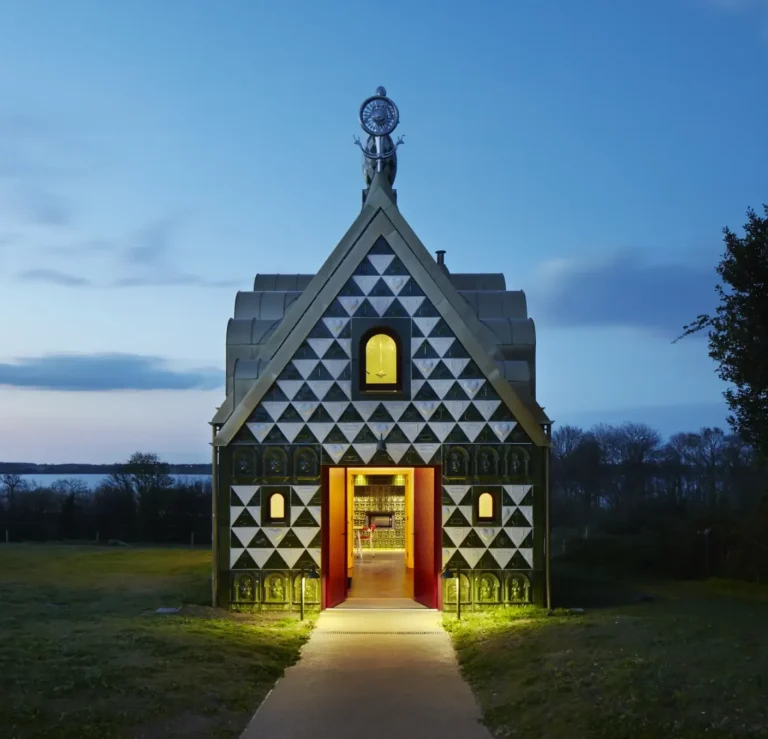Colour, Character, and Challenging Convention:
'Reflections on Charles Holland and the Evolution of Architectural Thought'
When I reflect on the formative years of my architectural journey, one name continues to resonate with clarity and significance: Charles Holland. As a tutor at the University of Brighton during my Master’s studies, Charles did far more than teach—he challenged, provoked, and inspired. The conversations we had in those studio sessions weren’t just about plans and elevations; they were about meaning, culture, and the joy of architecture. Some of those lessons I’m only truly starting to understand now, all these years later.
Charles Holland is not a quiet voice in the world of architecture—his work speaks boldly and vividly. From his early days as a key figure in FAT (Fashion Architecture Taste), to the founding of his own practice Charles Holland Architects, his career has been exemplary in its refusal to follow the safe or conventional path. He has consistently explored the boundaries of what architecture can be—not just as form or function, but as cultural expression, narrative, and joy.



Charles Holland is not a quiet voice in the world of architecture—his work speaks boldly and vividly. From his early days as a key figure in FAT (Fashion Architecture Taste), to the founding of his own practice Charles Holland Architects, his career has been exemplary in its refusal to follow the safe or conventional path. He has consistently explored the boundaries of what architecture can be—not just as form or function, but as cultural expression, narrative, and joy.
Charles doesn’t design soulless edifices. His buildings are anything but anonymous. While often the product of a careful, incremental, and iterative design process, each work stands as a deeply individual expression—a piece of architectural research through making. It is a process of enquiry and refinement, searching for clarity through form, material, colour, and symbolism until the right note is struck. And when it is, the result resonates—visually, emotionally, and intellectually.
One of the most iconic examples of this approach is, without question, the House for Essex, a project he co-designed with artist Grayson Perry. Set in the rolling green of Wrabness, this is not a home in the traditional sense—it is a shrine, a sculpture, and a celebration of eccentric British identity. With its richly patterned tiles, ornate copper roof, and vivid colour palette, the house breaks almost every rule of restraint in domestic architecture. And yet, it works—beautifully. It’s a building that dares to be exuberant, to blend architecture and art, and to tell a story—both mythical and deeply human.
It’s precisely this spirit that Charles brings to his work and to his teaching. He encouraged us to think of buildings not just as machines for living, but as vessels for memory, emotion, humour, and even contradiction. He taught us that architecture can be both serious and playful, functional and decorative, high-minded and inclusive.
Charles’s recent work continues this ethos, with projects rooted in community, identity, and reinvention. His emphasis on public architecture that is joyful, characterful, and connected to place offers a powerful alternative to the often homogenised language of contemporary design. He is a staunch advocate for contextual creativity—an approach that doesn’t shy away from history, ornament, or narrative, but embraces them as tools for relevance and delight.
In revisiting his work and writing today, I find myself newly inspired. Architecture, as Charles reminds us, is not just a technical discipline—it is a cultural act. It shapes the spaces we inhabit, but it also shapes how we feel, how we remember, and how we belong.
His website’s Community section struck a chord with me recently, as I embark on my first major community-focused scheme—bringing together a cricket club, football club, and leisure centre in a shared effort to serve the local population. The ambition is not only to modernise, but to provide essential services such as training, food banks, accessible banking, Citizens Advice, and more—a true civic hub. In doing so, I find myself drawing on some of the ideas Charles impressed upon me: that buildings should have personality, serve real people, and, when possible, lift the spirit.
Looking back, I feel incredibly fortunate to have been taught by someone who pushed the conversation beyond conventional boundaries. Charles Holland made me question what architecture could be—not just as a profession, but as a form of cultural engagement. And for that, I am deeply grateful.
At its best, architecture tells stories, expresses identity, and brings people together. Charles’s work reminds us that these stories don’t need to be neutral, bland, or restrained—they can be rich, colourful, challenging, and deeply human.
Finally, architecture is something that is rooted in all our lives, and whether you're just curious about architecture or a top-flight architect, Charles’ latest book, How to Enjoy Architecture, published by Yale University Press in April 2024, is well worth a read!
image - Architect, Professor and writer Charles Holland.
Image couresty of Charles Holland Architects.
image - Front cover of Charles’ book titled How to Enjoy Architecture – click the image to be taken to Amazon, where you can purchase this excellent read.


